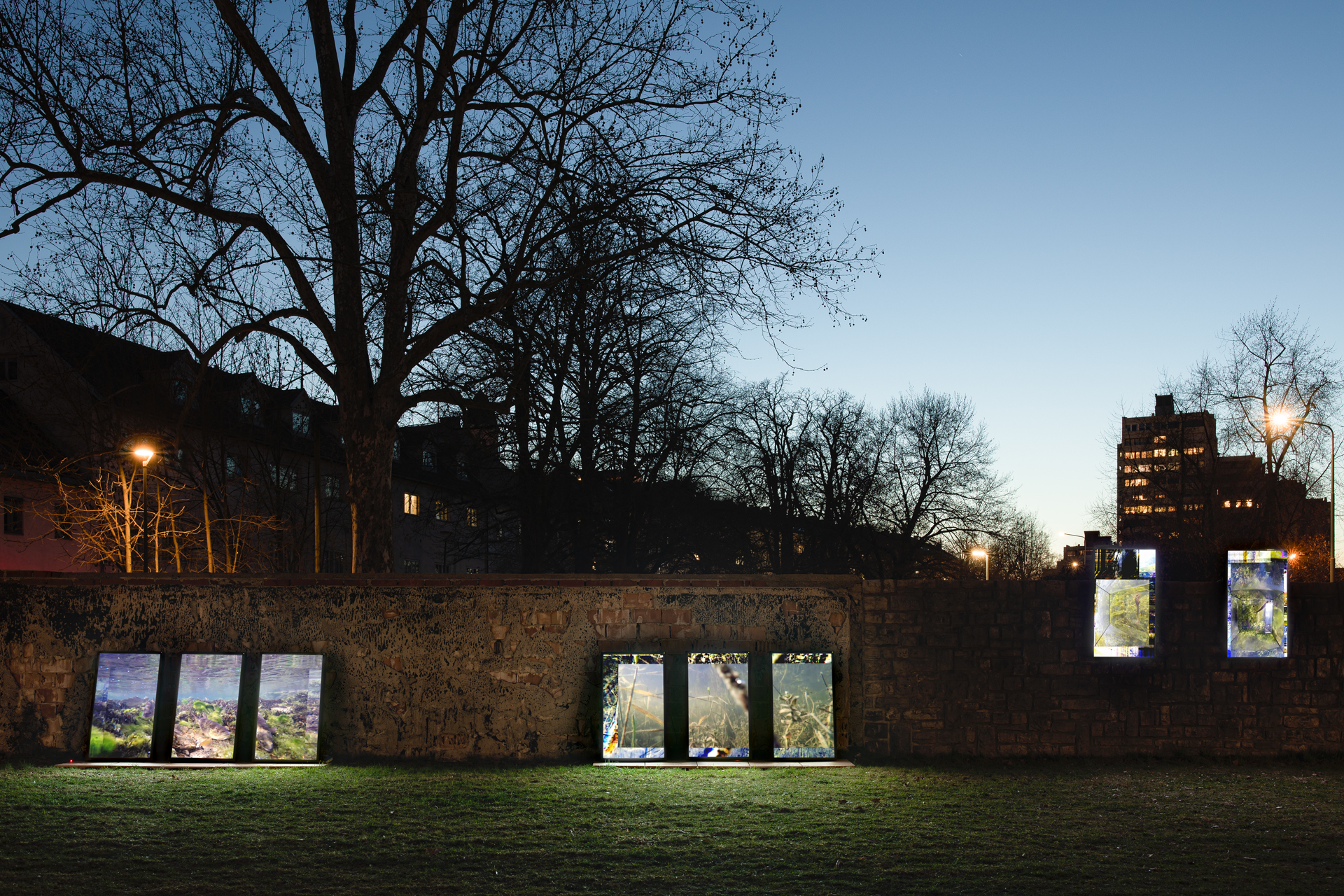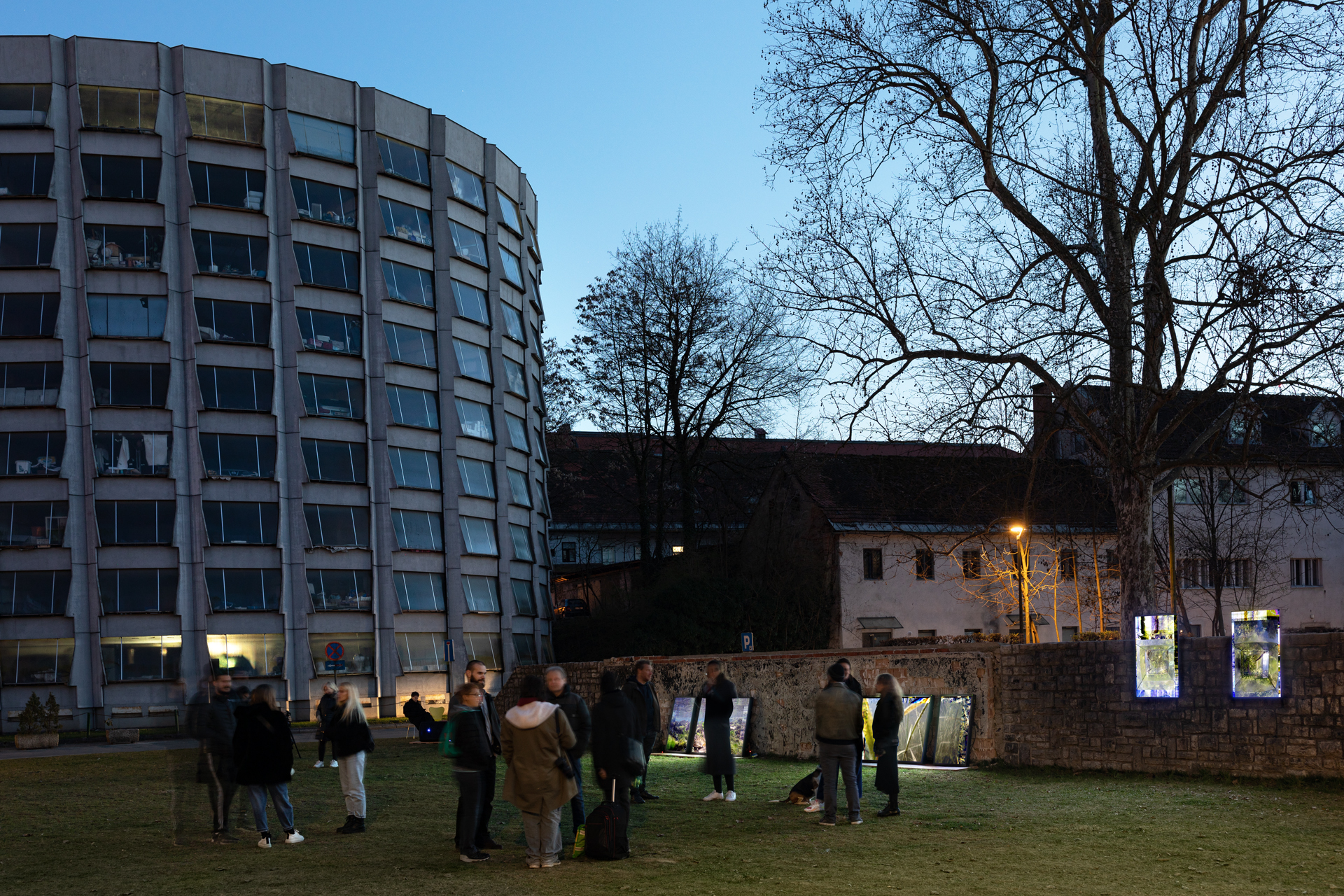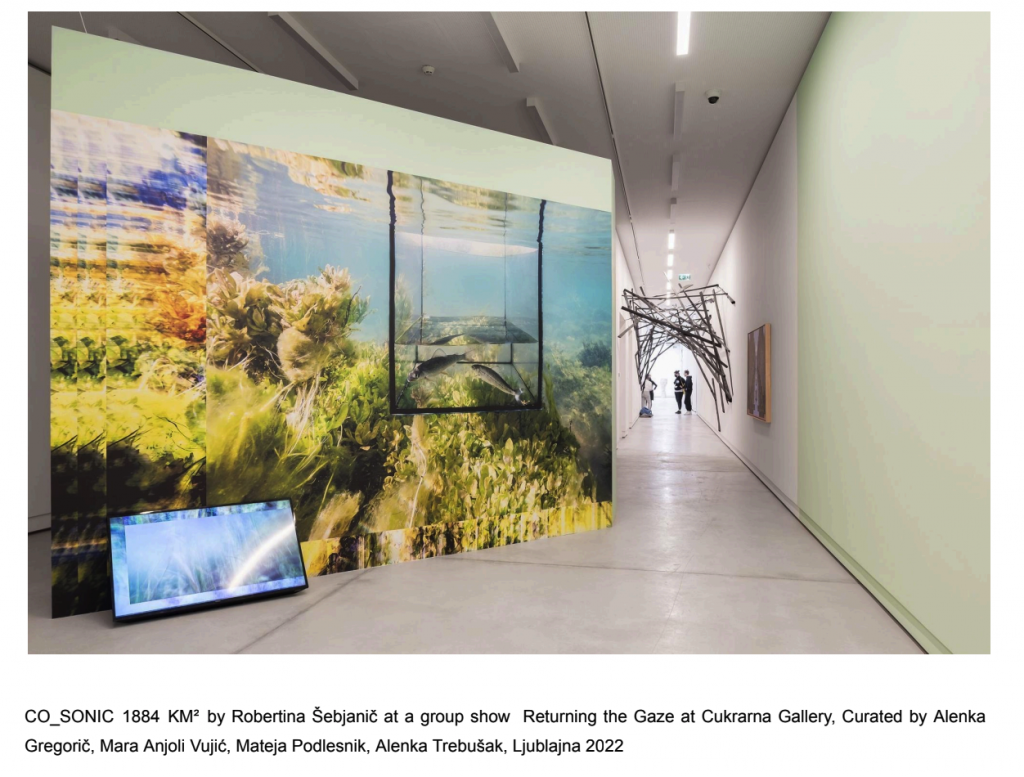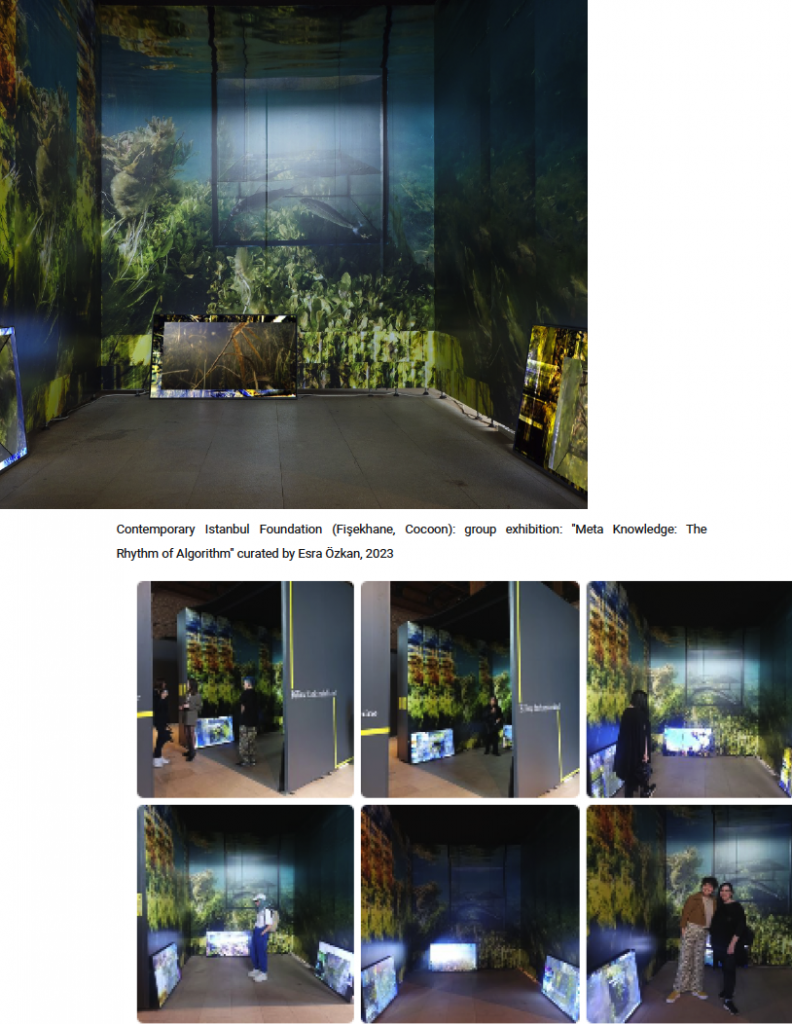
Co_Sonic 1884 km² is a audio/visual-poetic reflection and an AI-powered soundscape that tells the story of (co)existence between river environments and their inhabitants.
Throughout history, the Ljubljanica river has wormed its way below and above the surface. Unaware that they are the same river, people gave different names to each of the above-ground parts of the river. Co_Sonic 1884 km² shows the river’s body through the prism of its integral whole. The work is a document of the current times in which rivers are becoming powerless due to human intervention.
Rivers are dynamic bodies of water, constantly changing and shaping their beds. These changes occur on a space/time scale that is more easily perceived by the smaller creatures living on or near the riverbed than by humans. For this reason, the project Co_sonic 1884 km2 considers the river from the perspective of its animals. In doing so, Robertina Šebjanič departs from an anthropocentric view of the world and opens up a different way of looking at the “seven names of Ljubljanica” that we often overlook. This is a perception of the body of water – that has been given seven different names because the same river cuts a route through the underground karst and therefore, in some places, eludes our view, which is limited to the surface where it appears as separate bodies of water – as an integral whole.
This shift in perception of the river basin of Ljubljanica – including its karst upper reaches, the river itself, and its intermittent lakes – in its completeness is made possible by the very substance of water, both as a liquid that flows and as a biotope for different species of fish or olms. Just as the water moves, huchen, cactus roach, souffia, grayling and trout migrate along the river’s course. Olms, though normally confined to the underground karst caves, are sometimes brought to the surface by floods. Floods play an important role in the water cycle, providing food for organisms living underground. From the perspective of the Other, therefore, it is always the same waterway.
Through the use of sounds and images of the (co)habitation of different lifeforms in a range of river environments, both above and below the water, this project not only tells stories about the non-human inhabitants of these environments but also, more importantly, alerts us to the many ways in which humans affect aquatic environments, be it through riverbed regulation, navigation, regulation of biodiversity or exploitation of their natural resources. Co_sonic 1884 km2 presents us with a snapshot of the present time, when rivers around the world are losing their vitality as a result of human activity. The project also explores the concept of deep time and gives visitors an understanding of how the environment has developed over the ages, in ways that go far beyond the ecosystems we know today. It opens our eyes and prompts us to develop empathy towards non-human lifeforms, thereby changing our attitude to ecosystems, with a view to ensure their sustainability far into the future.






COLOPHONE
Artist (concept, sound & photo & video editing, execution): Robertina Šebjanič
Curator of the commission Cukrarna Gallery: Alenka Trebušak
Photo and video recording on the field: Miha Godec and Robertina Šebjanič
A.I. programming of audio: Moisés Horta Valenzuela
Voice: Polona Torkar, Zagi Zornada
Sound mastering: Mauricio Valdes and Robertina Šebjanič
Production of audio-video installation: Cukrarna Gallery 2021 / 2022 (Museum and Galleries of Ljubljana)
Co-production: Sektor Institute 2021/2022
Co-production of photo series: Quo Artist Fundation 2021
Technical support: Technical Service MGML, Ličer Solutions, MG+MSUM, Fish farm Obrh
This project was possible: City of Ljubljana
Special thanks: to 1884 km2 of riverbasin and the rivers, streams and lake: Trbuhovica, Obrh, Stržen, Cerkniško jezero, Rak, Pivka, Unica, Ljubljanica…
The project CO_SONIC 1884km2 by Robertina Šebjanič, is a commission work in a series of projects taking place in the run-up to the opening of Cukrarna Gallery.

https://mgml.si/en/city-museum/exhibitions/562/robertina-sebjanic-co_sonic-1884-km2/

SO_ZVOČJE 1884 KM²
So_zvočje 1884 km² je video/zvočna krajina, podprta s tehnologijo umetne inteligence, ki pripoveduje zgodbo o (so)bivanju rečnih okolij in njihovih prebivalcev. Z odmikom od antropocentričnega videnja sveta poskušam v tem projektu prikazati nov pogled na reko Ljubljanico in njen ekosistem. Tekom zgodovine si je Ljubljanica namreč vtrla pot pod- in nad povrsjem. Nevedoč, da gre za isto reko, so ljudje vsakemu nadzemnemu delu reke nadeli drugačno ime. So_zvočje 1884 km² prikaže telo reke skozi prizmo njene integralne celote in je dokument trenutnega časa, v katerem reke zaradi človekovega posega postajajo nemočne.
Reke so dinamična, stalno spreminjajoča se vodna telesa in nenehoma oblikujejo svoje struge. Spremembe potekajo v prostorsko-časovni dimenziji, ki jo lažje zaznavajo manjša bitja, živeča v gostejši resoluciji trenutkov. Avdiovizualni projekt Robertine Šebjanič So_zvočje 1884 km² zato reko presoja s stališča v njej bivajočih živali. Umetnica z odmikom od antropocentričnega videnja sveta razkriva pogled na Ljubljanico in njenih sedem imen, ki pogosto umanjka v našem zavedanju ekosistema reke. To je pogled na vodno telo – ki ga je človek skozi zgodovino dekonstruiral in mu nadel sedem različnih imen zgolj zato, ker si je kot ponikalnica med svojim potovanjem izdolblo strugo tudi v podzemni svet Krasa in večkrat uhaja našemu “površinskemu” pogledu – skozi prizmo celovitosti.
Zaznavanje celovitosti porečja Ljubljanice z njegovim kraškim zaledjem, ki ga sicer zaznamujejo reka in številna presihajoča jezera, najprej ponujata voda kot tekoča snov, in vodna pot kot biotop za ribe ali človeške ribice. Tako kot reka, ki teče, tudi sulec, platnica, blistavec, lipan in rečna postrv potujejo po rečnem toku. Ne nazadnje poplave, ki so pomemben dejavnik kroženja voda in v podzemlje prinašajo hrano tam živečim organizmom, tudi človeške ribice, sicer vezane na podzemni svet kraških jam, občasno prestavijo na površje. Iz perspektive Drugega torej vedno gre za isto vodno pot.
Projekt nam s svojim zvočnim in slikovnim zapisom različnih pod- in nadvodnih rečnih okolij ne približa zgolj zgodb njihovih »nečloveških« prebivalcev, temveč nas predvsem opozarja na točke človekovega nadzora vodnega okolja, najsi gre za regulacijo rečnih strug, izkoriščanje njihove plovnosti in izčrpavanje njihovih naravnih virov ali pa za uravnavanje njihove biotske raznovrstnosti. Prav zato lahko So_zvočje 1884 km² razumemo kot dokument trenutnega časa, v katerem reke po vsem svetu zaradi naših posegov postajajo nemočne. Projekt se na več ravneh ukvarja tudi s pojmom globokega časa in zmožnostjo razumevanja zgodovinskega razvoja okolja, ki sega onkraj stanja ekosistemov tukaj in zdaj. Napeljuje nas k prilagajanju čutov in sprejemanju strategij za razvoj empatije do “nečloveških” entitet z namenom vzpostavljanja odnosa z ekosistemi za čas, ko naše generacije že davno ne bo več.
KOLOFON
Umetnica (koncept, zvok, fotografija & video montaža, izvedba): Robertina Šebjanič
Kustosinja: Alenka Trebušak
Foto in video snemanje na terenu: Miha Godec
U.I. programiranje zavoka: Moisés Horta Valenzuela
Glasovi: Polona Torkar, Zagi Zornada
Zvočni mastering: Mauricio Valdes and Robertina Šebjanič
Produkcija: Muzej in galerije mesta Ljubljane 2021/2022
Koprodukcija: Zavod Sektor 2021/2022
Koprodukcija serije fotografij: Quo Artist Fundation 2021
Tehnična podpora: tehnična služba MGML, Ličer Solutions, MG+MSUM, Ribogojnica Obrh
Projekt je omogočila: Mestna občina Ljubljana
Posebna zahvala: 1884 km2 porečja in rekam, potokom in jezeru: Trbuhovica, Obrh, Stržen, Cerkniško jezero, Rak, Pivka, Unica, Ljubljanica …
https://mgml.si/sl/mestni-muzej/razstave/562/robertina-sebjanic-so_zvocje-1884-km2/








